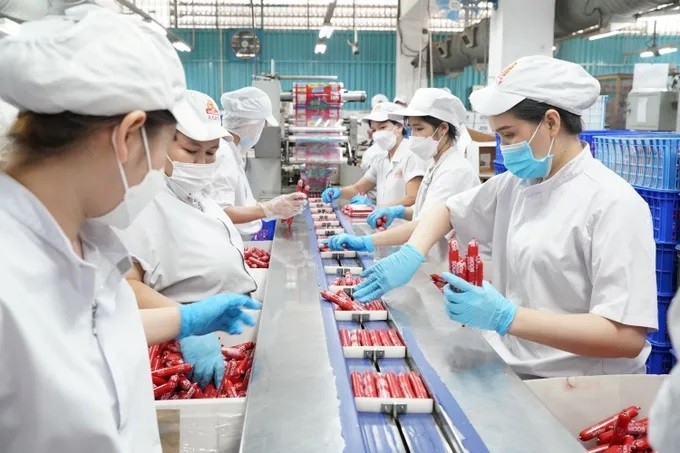Domestic momentum powering Vietnamese goods to global markets
Experts highlight that Vietnam is now one of the world’s 20 most open economies, with total import-export turnover in 2024 reaching over 786 billion USD, up more than 15% compared to the previous year.
Key sectors such as textiles and garments, wood and furniture, electronics, food processing, seafood, and industrial equipment have become internationally competitive, contributing to a dynamic and diversified industrial ecosystem.
    |
 |
|
Product packaging line at the Vietnam Meat Industries Joint Stock Company (Vissan) |
Nguyen Quoc Khanh, Chairman of AA Corporation and Vice Chairman of the Vietnam Timber and Forest Products Association (VIFOREST), said Vietnam holds vast potential in deep-processing industries. In the green furniture segment alone, he noted, efficient use of resources could lift wood exports to 30 billion USD by 2035 while promoting globally competitive supporting industries.
Meanwhile, the food and beverage processing sector was valued at more than 79 billion USD in 2024, accounting for nearly one-fifth of national industrial output and maintaining average annual growth of around 7%, international research indicates. The packaged food market is expected to reach 26.9 billion USD by 2028, creating strong incentives for domestic firms to invest in sustainable packaging, modern processing technologies, and product traceability to meet growing global demand.
According to Vu Ba Phu, Director General of the Trade Promotion Agency under the Ministry of Industry and Trade, global markets continue to view Vietnamese enterprises as reliable producers and exporters. Vietnam’s textile and garment industry ranks among the world’s top three with export earnings of 42.1 billion USD in 2024, while wood and furniture exports rank second globally and seafood exports total 10 billion USD.
These results show that Vietnamese products, recognized for sustainability, cultural distinctiveness, and compliance with ESG standards, are increasingly acknowledged worldwide, affirming Vietnam’s rising status in global supply chains, he said.
Enhancing supply chain resilience
Despite robust growth, Vietnam’s industrial structure remains vulnerable, said Dr. Pham Thi Hong Phuong, Senior Advisor at the Innovation Center of the Ho Chi Minh City University of Industry. Many firms still depend on processing, imported materials, and foreign supply chains, with up to 60% of raw materials in the food industry sourced from overseas.
To strengthen self-reliance, experts recommend that Vietnamese businesses adopt circular production models, invest in recycling and clean energy technologies, and implement green supply chain management aligned with ESG standards to qualify for major export markets such as the E.U., the U.S., and Japan.
Enterprises also agree that Vietnam must move beyond its reliance on low-cost labor and basic processing. They emphasize the need to build “localization alliances” linking companies, research institutions, and universities to develop domestic industrial clusters and complete component ecosystems.
As over 90% of Vietnamese firms are small and medium-sized, collaboration is essential to enhance competitiveness in global supply chains. Through joint efforts, the country aims to raise localization rates to 50% by 2030, building an autonomous manufacturing base that supports the international expansion of Vietnamese products.
To create more room for domestic growth, Tran Tien Dung, General Director of Dai Dung Group, urged the State to open up opportunities for local enterprises to take part in national key projects. Across Vietnam, large-scale investments are underway in transport, metro systems, renewable energy, equipment manufacturing, and industrial construction, with total funding worth tens of billions of U.S. dollars.
He described this as a “golden opportunity” for Vietnamese industry to leap forward, provided that policies are fine-tuned to enable deeper participation of domestic enterprises in the value chain.
However, businesses still face significant constraints, limited long-term financing, difficulty accessing green credit for technological upgrades, and industrial land costs that remain higher than those in regional peers.
Furthermore, existing bidding mechanisms often prevent Vietnamese firms from taking part in strategic projects such as metro lines, gas-fired power plants, and petrochemical complexes.
Experts propose establishing a network of local supporting industries through public-private partnerships, linking enterprises of different sizes to form a self-sufficient supply chain. They also recommend allowing conditional direct contracting for projects with at least 50% local content, allocating strategic industrial land for domestic investors, and expanding access to green credit for technology-driven development.
Source: VNA